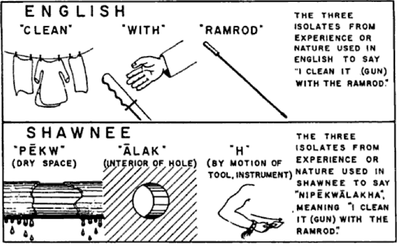2 Chapter 2: Culture – The Human-Shaped World
Five Characteristics of Culture
The concept of the Anthropocene relates to the current geological epoch, where human activity has become the dominant force shaping the earth’s ecosystems and challenges traditional views of humans as separate from and superior to nature.
In the previous chapter, we learned that sociology is the scientific study of the human-shaped structure, which is under the “umbrella” of the human-shaped world, culture. Sociology is the study of a subset of culture. Sociology looks at the social structure, the time you are alive, and the sustaining institutions you interact with and are shaped by. For example, almost every human behavior, from shopping to marriage, is learned. In the U.S., marriage is generally seen as an individual choice made by two adults based on mutual feelings of love. In other nations, marriages have been arranged through interviews and negotiations between families. In Papua New Guinea, almost 30 percent of women marry before age 18, and 8 percent of men have more than one wife (National Statistical Office, 2019). To people not from such a culture, arranged marriages may seem to have risks of incompatibility or the absence of romantic love. But many people from cultures where marriages are arranged, including many highly populated and modern countries, often prefer the approach because it reduces stress and increases stability (Jankowiak 2021).
But now, we want to analyze the broader criteria of culture and thematically link culture to all the other stuff we will see in the rest of the book. Everything will flow back to these characteristics. Review the persuasion map (Figure 1.5) in chapter 1 if you need some more examples of whether something is or is not culture.
All culture is related to five major characteristics:
- Culture is a human construct (human-shaped).
- Culture is linked to time (collectively shaped product of history).
- Culture is associated with societal values (regional).
- Cultural universals exist in every society (global).
- Culture is shaped primarily by those with power.
1. Culture is a human construct (human-shaped)
Before humans, the world was cultureless. We had to make everything. Culture is not a natural phenomenon; it is all human-shaped because it is created and maintained through social interaction and communication by human beings. Without us, culture does not exist. No other animals, not elephants, monkeys, and certainly not dinosaurs, have culture. For example, we are the only animal species on earth that requires money to live, money being a human construct and invention. However, we can divide this further into non-material and material culture for a better understanding.
Culture can be material or non-material. Metro passes, and bus tokens are part of material culture, as are the buses, subway cars, and the physical structures of the bus stop. Think of material culture as items you can touch – they are tangible. Non-material culture, in contrast, consists of a society’s ideas, attitudes, and beliefs. These are things you cannot touch. They are intangible. For example, beliefs refer to convictions or opinions about a particular subject or idea. They often form the basis of cultural attitudes and practices; we will explore these values, norms, and more in the third characteristic below. Beliefs can be shaped by many factors, including institutions of the social structure like religion, education, family, or even personal experience. Take, for example, the picture below in Figure 2.1. You may believe people should wait in an orderly line or queue to enter an event in an arena, amusement park ride, or public transportation. Those beliefs are intangible because they do not have physical properties and cannot be touched.

Material and non-material aspects of culture are linked, and physical objects often symbolize cultural ideas. A metro pass is a material object but represents a form of non-material culture, namely, capitalism and the acceptance of paying for transportation. Clothing, hairstyles, and jewelry are part of material culture. Still, the appropriateness of wearing certain clothing for specific events reflects non-material culture. A school building belongs to material culture, symbolizing education. Still, the teaching methods and educational standards are part of education’s non-material culture.
As people travel from different regions to entirely other parts of the world, particular material and non-material aspects of culture become dramatically unfamiliar. What happens when we encounter different cultures? As we interact with cultures other than our own, we become more aware of the differences and commonalities between others and our own. If we keep our sociological imagination awake, we can begin to understand and accept the differences. Body language and hand gestures vary around the world. Still, some body language seems to be shared across cultures: When someone arrives home later than permitted, a parent or guardian meeting them at the door with crossed arms and a frown on their face means the same in Russia as it does in the U.S. as it does in Ghana.
Take the case of going to work on public transportation. Whether people are commuting in Egypt, Ireland, India, Japan, and the U.S., many behaviors will be the same and may reveal patterns. Others will be different. In many societies that enjoy public transportation, a passenger will find a marked bus stop or station, wait for the bus or train, pay an agent before or after boarding, and quietly take a seat if one is available. But when boarding a bus in Cairo, Egypt, passengers might board while the bus is moving because buses often do not come to a complete stop to take on patrons. In Dublin, Ireland, bus riders would be expected to extend an arm to indicate that they want the bus to stop for them. And when boarding a commuter train in Mumbai, India, passengers must squeeze into overstuffed cars amid a lot of pushing and shoving on the crowded platforms. That kind of behavior might be considered rude in other societies. Still, in Mumbai, it reflects the daily challenges of getting around on a train system that is taxed to capacity.
Humans, consciously and subconsciously, constantly strive to make sense of their surrounding world. Symbols—gestures, signs, objects, signals, and words—help people understand that world. They provide communication methods to understand experiences by conveying recognizable meanings shared by societies.

The world is filled with symbols. Sports uniforms, company logos, and traffic signs are symbols. In some cultures, a gold ring is a symbol of marriage. Some symbols are highly functional; stop signs, for instance, provide helpful instruction. They belong to material culture as physical objects, but because they function as symbols, they also convey non-material cultural meanings. Some symbols are valuable only in what they represent. For example, trophies, blue ribbons, or gold medals represent accomplishments. But many objects have both material and non-material symbolic value.
Some symbols represent only one side of the story and elicit strong emotions, which can lead to social unrest. Their presence is a reminder of a nation’s worst times and not something to celebrate. Many of these symbols are targets of vandalism, as the destruction of these representations is symbolic. Effigies representing public figures are burned to demonstrate anger at certain leaders. In 1989, crowds tore down the Berlin Wall, a decades-old symbol of the division between East and West Germany, communism, and capitalism. In the U.S., beginning in 2019, statues associated with slavery and the Civil War were removed from state capitols, college campuses, and public parks. In Germany, any display of Hitler or Nazi memorabilia or to deny the Holocaust is illegal.
While different cultures have varying symbols, one system is common to all: language. Whatever its form, people learn social and cultural norms through it.
Language is the most significant shaper of non-material culture (and all culture). Language is considered a part of non-material culture because it is not a physical object or artifact but a communication system that a group of people shares. Language is an intangible aspect of culture passed down from generation to generation and helps shape how people think, understand the world, and interact. Language is essential to non-material culture because it allows people to express their thoughts, beliefs, and emotions and transmit cultural knowledge and values. It is a tool for socialization and helps shape individual and collective identity by defining what is expected, acceptable, and desirable within a particular cultural group.
Language is a system that uses symbols with which people communicate and through which culture is transmitted. Letters (which make up words), pictographs, and hand gestures are all symbols that create a language used for communication. Sign language, for example, requires an intimate knowledge of an alphabet and signs that represent entire words and the meaning indicated by certain facial expressions or postures. Its grammar differs from the spoken language. As spoken language differs across regions, nations and cultures, and can even vary by the person’s age, so does sign language.
All language systems contain the same essential elements that effectively communicate ideas – object, subject, and action. A written language system consists of symbols that refer to vocal sounds. Taken together, these symbols convey specific meanings. The English language uses a combination of twenty-six letters to create words. These twenty-six letters are over 600,000 recognized words (OED Online, 2011). We can compare the reliance on tone and inflection to Mandarin Chinese. It contains over 8,000 characters, but the same character may symbolize different concepts depending on the tone used.
Rules for speaking and writing vary even within cultures, most notably by region. Do you eat a grinder, a sub, or a hero/gyro? Do you refer to a can of carbonated liquid as “soda” or “pop”? Is a household entertainment room a “family room,” “rec room,” or “den”? When leaving a restaurant, do you ask your server for a “check,” the “ticket,” or your “bill”? Language is constantly evolving and adding new words as societies create new ideas. In this age of technology, many cultures have adapted almost instantly to new nouns such as “e-mail” and “Internet,” and verbs such as “downloading,” “texting,” and “blogging.” These would have been considered nonsense words just the world twenty-five years ago.
Language and Culture
While it constantly evolves, language shapes our perception of reality and behavior. In the 1920s, linguists Edward Sapir and Benjamin Whorf advanced the Sapir-Whorf hypothesis or linguistic relativity. It is based on the idea that people experience their world through their language, and therefore understand their world through the cultural meanings embedded in their language. The hypothesis suggests that language shapes thought and, thus behavior (Swoyer, 2003). For example, words have attached meanings beyond their definition that can influence thinking and behavior. In the U.S., where thirteen is associated with bad luck, many high-rise buildings do not have a 13th floor. In Japan, however, the number four is considered unlucky since it is pronounced similarly to the Japanese word for “death.”

Many sociologists believe that language can have a broad and lasting impact on perception. In 2002, Lera Boroditsky and her colleagues conducted experiments on native German and Spanish speakers in English. Unlike English, these languages assign genders to nouns. In German, for example, the word for sun, die Sonne, is feminine, but the word for moon, der Mond, is masculine. The team chose a set of nouns with opposite genders in German and Spanish and asked participants to provide adjectives to describe them. They found that German speakers used more masculine adjectives than Spanish speakers when describing a grammatically masculine noun in German but feminine in Spanish. For example, the word for key is masculine in German and feminine in Spanish. German speakers described keys as hard, heavy, jagged, metal, serrated, and useful, while Spanish speakers used the adjectives golden, intricate, little, lovely, shiny, and tiny. The team concluded that gender perceptions acquired in a person’s native language carry forward to how they see the world even when they switch to a language without grammatical genders (Boroditsky, Schmidt, and Phillips, 2002).
Some sociologists also believe language structure can affect individual and group behavior. For example, a series of studies have found that Finland has a significantly higher rate of workplace accidents than Sweden despite the languages having similar workplace regulations (Salminen & Johansson, 2000). John A. Lucy explained this discrepancy through differences in the structure of these languages. Swedish places a greater emphasis on the timing of movement in three-dimensional space. Consequently, Lucy argued, the Swedish factories are physically arranged to support the smooth running of the product process. Finnish factors experience frequent disruptions, so workers must rush and have more accidents (Lucy, 1997).
The Sapir-Whorf hypothesis has been interpreted to suggest that if a word does not exist in a language, then users of that language cannot have the experience. Studies have shown, for instance, that unless people have access to the word “ambivalent,” they don’t recognize having conflicting positive and negative feelings about an issue as ‘ambivalence.’ However, the hypothesis should not suggest that people do not have conflicting feelings but rather that they interpret the feelings differently.
In addition to using spoken language, people communicate without words. Nonverbal communication is symbolic and, as in the case of language, is learned through one’s culture. Some gestures are nearly universal; some are not. Smiles often indicate positive reinforcement in the U.S.; in some cultures, it is rude as you do not know the person. A thumbs-up in Russia and Australia is an offensive curse (Passero, 2002). Other gestures vary in meaning depending on the situation and the person. A wave of the hand can mean many things, depending on how it’s done and for whom. It may mean “hello,” “goodbye,” “no thank you,” or “I’m royalty.” Winks convey a variety of messages, including “We have a secret,” “I’m only kidding,” or “I’m attracted to you.” From a distance, a person may “read” the emotional situation of people just by watching their body language and facial expressions. However, many cultures communicate with many physicalities, which people outside that culture may interpret as an argument. So, for example, you might believe two people are arguing when, in fact, they are simply having a regular conversation.
2. Culture is linked to time (collectively shaped product of history).

3. Culture is associated with societal values (regional).
4. Cultural universals exist in every society (global).

5. Culture is shaped primarily by those with power.
Chapter Summary
Sociology is the scientific study of the human-shaped structure. And culture is the human-shaped world, which means sociology is the study of a subset of culture. Culture divides into material and nonmaterial aspects. All culture is related to five major characteristics:
- Culture is a human construct (human-shaped).
- Culture is linked to time (collectively shaped product of history).
- Culture is associated with societal values (regional).
- Cultural universals exist in every society (global).
- Those with power primarily shape culture.
Ethnocentrism occurs when a person uses their own society’s culture to judge another. Cultural relativism consists of a deliberate effort to appreciate a group’s ways of life in its context without prejudice. Groups with a common interest may form a subculture, a subset of the dominant culture in a society with distinct values, beliefs, and norms. Countercultures are those whose value systems are in opposition to the values of the dominant culture. Ideal culture represents the values a culture aspires to, and real culture represents a culture’s actual behaviors.
Major Points of the Chapter
After reading this chapter, you should be able to:
- Explain what culture is.
- List the five major characteristics of culture.
- Differentiate between non-material and material culture.
- Differentiate between ethnocentrism and cultural relativism.
- Contrast subcultures and countercultures.
- Explain the difference between real and ideal culture.
Attributions
Figure 2.1 “Smiling Tibetan women queueing tightly into line for long life initiation, mala, chubas traditional striped aprons, Tharlam Monastery courtyard, Tibetan Buddhist, Boudha, Kathmandu, Nepal” by Wonderlane is licensed under CC BY 2.0.
https://en.wikipedia.org/wiki/File:Whorf_Shawnee_Example.png
“Row of traditional incandescent lightbulbs” by wuestenigel is licensed under CC BY 2.0.
“16 religious symbol” by Ìṣẹ̀ṣeAssembly is licensed under CC BY-SA 4.0.
“IMG_3755 Easy Breezy Hippie Folks” by Rojer is licensed under CC BY 2.0.

